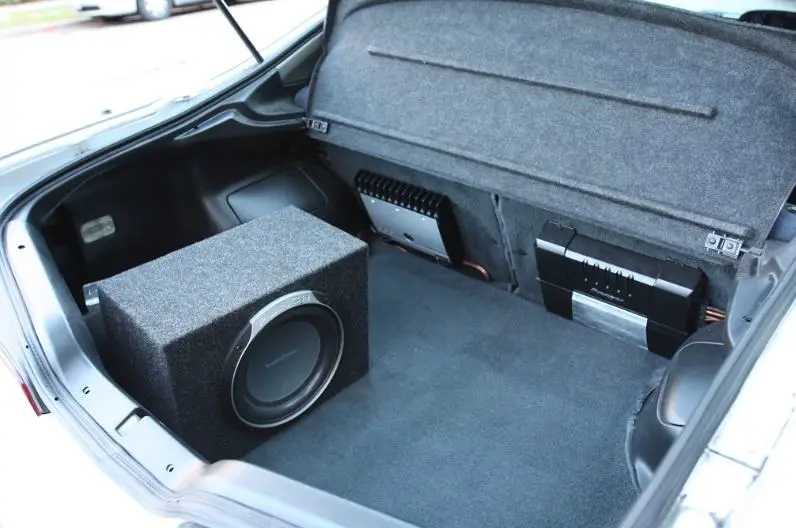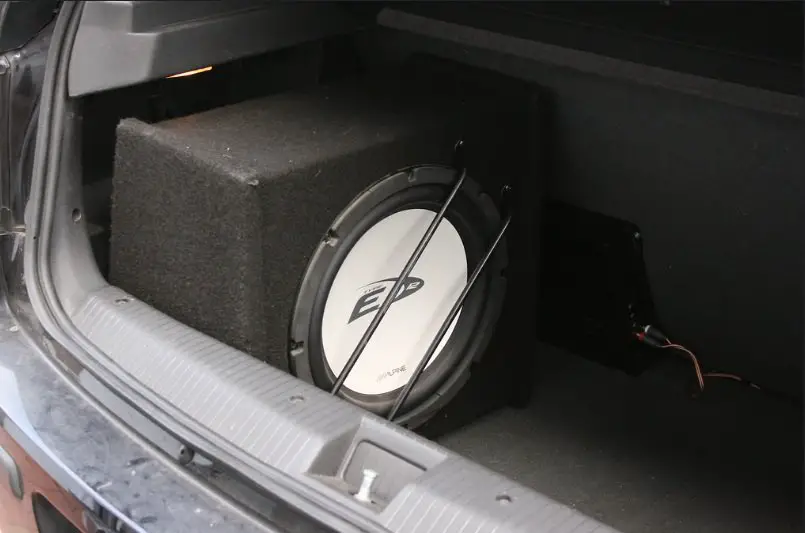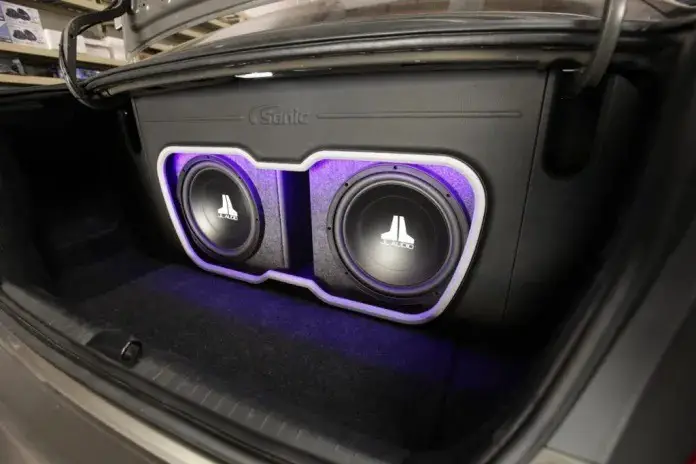A subwoofer is a type of speaker that is specifically designed to produce low-frequency sounds, also known as bass.
These sounds are typically in the range of 20Hz to 200Hz and are responsible for adding depth and impact to music and movie soundtracks.

In a car, a subwoofer can enhance the overall listening experience by providing a more dynamic and immersive audio experience.
However, to achieve optimal sound quality, it is important to properly place the subwoofer in the trunk of the car.
Factors to Consider when Placing a Subwoofer in a Trunk
When deciding on the best placement for a subwoofer in a trunk, there are several factors to consider.
Space Availability
The first is the available space in the trunk. The subwoofer should be placed in an area that is large enough to accommodate it, while also leaving enough room for other items that may need to be stored in the trunk.
Subwoofer Type
The type of subwoofer is also an important factor to consider. There are two main types of subwoofers, sealed and ported.
Sealed subwoofers are also known as acoustic suspension and they have a sealed enclosure that allows for tight and accurate bass reproduction.
Ported subwoofers, also known as bass reflex, have a port or vent in the enclosure that allows for more output and larger low-frequency response.
Listening Preference
Lastly, your personal listening preferences is also a factor to be considered.
Some people prefer a more balanced and accurate sound, while others may prefer a more bass-heavy sound.

Facing the Subwoofer Forward
One option for subwoofer placement in a trunk is to face it forward. This means that the front of the subwoofer is pointing towards the rear of the car.
This configuration has several advantages. One is that it allows for a more accurate and precise sound reproduction, as the subwoofer is able to radiate sound in a more controlled manner.
Additionally, this configuration is less likely to cause any rattling or vibration in the trunk, as the subwoofer is facing away from the trunk walls.
However, one of the main disadvantage of this configuration is that it may not produce as much output as other configurations.
This is why it is recommended for sealed subwoofers which have a tighter and more accurate bass reproduction.
In short, facing the subwoofer forward in a trunk can provide a more precise and accurate sound reproduction.
However, it may not produce as much output as other configurations.
It is recommended for sealed subwoofers which have a tighter and more accurate bass reproduction.
Facing the Subwoofer Upward
Another option for subwoofer placement in a trunk is to face it upward.
This means that the top of the subwoofer is pointing towards the rear of the car. This configuration has several advantages as well.
One is that it allows for a larger low-frequency response as the port or vent of the ported subwoofers can radiate sound more efficiently.
Additionally, this configuration can produce more output and bass than other configurations, making it ideal for those who prefer a more bass-heavy sound.
However, one of the main disadvantages of this configuration is that it can cause some distortion in the sound reproduction.
This is because the sound waves may bounce off the trunk ceiling, causing phase cancellation and distortion.
It is recommended for ported subwoofers which have a larger low-frequency response and more output.
Facing the Subwoofer Downward
The last option for subwoofer placement in a trunk is to face it downward. This means that the bottom of the subwoofer is pointing towards the rear of the car.
This configuration is not recommended, as it can cause distortion in the sound reproduction.
This is because the sound waves may be blocked or absorbed by the trunk floor, causing phase cancellation and distortion.
Additionally, it can cause rattling and vibration in the trunk.

Conclusion
In conclusion, when placing a subwoofer in a trunk, it is important to consider the available space, the type of subwoofer, and your personal listening preferences. Facing the subwoofer forward can provide a more precise and accurate sound reproduction, but may not produce as much output.
Facing the subwoofer upward can produce more output and bass, but can cause distortion in the sound reproduction.
Facing the subwoofer downward is not recommended, as it can cause distortion in the sound reproduction, rattling and vibration.
It’s also worth noting that, it’s better to test and experiment with different configurations, and use your own ears to decide which configuration sounds the best for your car and your preferences.
How much space do I need in my trunk to properly place a subwoofer?
The amount of space needed in the trunk will depend on the size of the subwoofer and the type of enclosure it has.
As a general rule of thumb, you should have at least 1 cubic foot of space for every 12 inches of subwoofer diameter.
Additionally, it’s important to ensure that the subwoofer can fit in the trunk without interfering with other items that may need to be stored there.
Can I place a ported subwoofer in a sealed enclosure?
While it is technically possible to place a ported subwoofer in a sealed enclosure, it is not recommended. Ported subwoofers are designed to have a specific volume of air inside the enclosure to produce the best sound quality. When placed in a sealed enclosure, the subwoofer may not perform at its best and may produce distorted sound.
Can I place a subwoofer in a trunk that has a sloping shape?
Placing a subwoofer in a trunk with a sloping shape can be a bit trickier than placing it in a trunk with a flat bottom.
However, it is still possible to achieve optimal sound quality by experimenting with different subwoofer placement options.
It may also be helpful to use a subwoofer box that is specifically designed to fit in a trunk with a sloping shape.
Can I face my subwoofer in different directions and still achieve the same sound quality?
The direction in which the subwoofer is facing can greatly impact its sound quality.
Facing a subwoofer forward can provide a more precise and accurate sound reproduction, while facing it upward or downward can produce more output.
It is important to experiment with different subwoofer placement options to find the one that best suits your personal listening preferences.
What are the best ways to test and adjust the subwoofer placement in my trunk?
One of the best ways to test and adjust subwoofer placement in a trunk is to use a sound pressure level (SPL) meter.
This tool can help you measure the level of sound at different points in the trunk, allowing you to fine-tune the subwoofer placement for optimal sound quality.
Additionally, you can test your subwoofer placement by listening to a variety of different types of music, and make adjustments until you achieve the desired sound quality.
